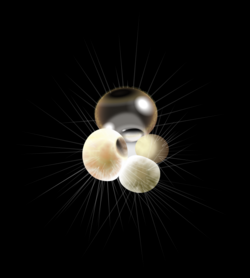Biology:Globigerinida
| Globigerinida Temporal range: M Jurassic - Recent
| |
|---|---|

| |
| Scientific classification | |
| (unranked): | |
| (unranked): | |
| Phylum: | |
| Subphylum: | |
| Class: | |
| Order: | Globigerinida Carpenter, Parker & Jones, 1862
|
| Superfamilies | |
|
Globigerinacea | |
The Globigerinida is an order of foraminiferans that are found as marine plankton. They produce hyaline calcareous tests, and are known as fossils from the Jurassic period onwards. The group has included more than 100 genera and over 400 species, of which about 30 species are extant. One of the most important genera is Globigerina; vast areas of the ocean floor are covered with Globigerina ooze (named by Murray and Renard in 1873), dominated by the shells of planktonic forms.
Description
Globigerinids are characterized by distinctly perforate planispiral or trochospiral tests composed of lamellar radial hyaline (glassy) calcite, with typically globular chambers and single interiomarginal aperture. Some however have multiple or auxiliary apertures, and in some the aperture is areal or terminal in location. Some, also, have keels, reinforcing thickenings along exterior angles. An adaptation to the planktonic habit is the development of long narrow spines that support a frothy buoyant ectoplasm.
References
- Chisholm, Hugh, ed. (1911). "Globigerina". Encyclopædia Britannica (11th ed.). Cambridge University Press
- Cushman Joseph A 1950 Foraminifera, their classification and economic use (4th ed) Harvard University Press, Cambridge, Massachusetts
- Loeblich, A. R. Jr and H. Tappan, 1964. Sarcodina Chiefly "Thecamoebians" and Foraminiferida; Treatise on Invertebrate Paleontology, part C Protista 2.
- ___—____, 1988. Classification of the Foraminifera
- Sen Gupta B. K. 1992. Systematics of Modern Foraminifera
External links
Wikidata ☰ Q133467 entry

